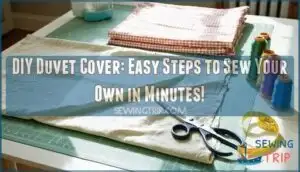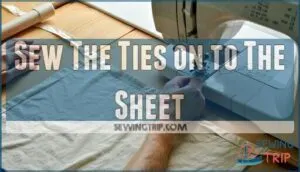This site is supported by our readers. We may earn a commission, at no cost to you, if you purchase through links.
 You’ll create a professional-looking DIY duvet cover in under an hour using just two flat sheets, scissors, and basic sewing skills.
You’ll create a professional-looking DIY duvet cover in under an hour using just two flat sheets, scissors, and basic sewing skills.
Start by measuring your comforter and adding 4 inches to each dimension. Cut your sheets to size, then sew three sides together with a half-inch seam allowance, leaving one short end open.
Flip inside-out for clean edges, then add ties or buttons to the opening for easy closure. This budget-friendly project costs half the price of store-bought versions while giving you complete control over fabric choice and design.
The secret lies in choosing the right sheet quality and mastering a few professional finishing techniques that transform basic materials into bedroom luxury.
Table Of Contents
- Key Takeaways
- How to DIY a Duvet Cover
- Find The Right Size Sheet
- Sew The Sheets Together
- Flip The Sheet Inside Out
- Make The Ties
- Sew The Ties on to The Sheet
- Customize Your Duvet Cover With Contrasting Patterns
- Benefits of Using a Duvet Cover
- Follow for More DIY Ideas and Tips
- Frequently Asked Questions (FAQs)
- Conclusion
Key Takeaways
- You’ll save significantly by making your own duvet cover – it costs half the price of store-bought versions while giving you complete control over fabric choice and design
- Basic sewing skills are all you need – this project requires only two flat sheets, scissors, and simple straight seams, making it perfect for beginners who want professional-looking results
- Proper measurements are crucial – add 4 inches to your comforter’s dimensions and pre-wash your fabric to prevent shrinkage issues that’ll make your finished cover too tight
- Strategic closures keep everything secure – whether you choose ties, Velcro strips, or buttons for the opening, proper placement prevents your duvet insert from shifting and bunching inside the cover
How to DIY a Duvet Cover
You’ll turn your bedroom into a cozy haven with just a few simple steps and basic sewing skills.
Creating your own duvet cover lets you choose the perfect fabric while saving money compared to store-bought options.
Getting Measurements
Everyone knows accurate measurements make or break your DIY project, so grab your tape measure and capture your comforter’s exact insert dimensions.
Don’t forget to add seam allowance for proper fit.
- Measure length, width, and thickness of your duvet insert for precise fabric measurements
- Check size charts against your mattress dimensions to prevent shifting during sleep
- Account for fabric width limitations when calculating total yardage needed for your project
Different sizes affect the overall duvet dimensions.
Prepare The Duvet Top Layer
Precision matters when preparing your DIY duvet cover’s top layer.
Precise measurements and quality fabric selection create professional-looking results every time.
Start with fabric selection, choosing cotton or linen that matches your style vision.
Cut fabric panels according to your measurements, adding seam allowance for clean edges.
Consider pattern considerations—stripes need careful alignment, while solids offer forgiving flexibility.
Verify that fabric width accommodates your duvet dimensions, joining panels if needed for proper coverage.
Many prefer cotton duvet covers for their breathability.
Prepare The Duvet Bottom Layer
While your top layer sits ready, it’s time to tackle the bottom panel using flat sheet selection for easier construction.
Cut your flat sheet to match your duvet dimensions, then create an envelope flap design by folding and hemming one edge.
This pocket construction method guarantees securing bottom layer stability while allowing easy duvet insertion through the opening.
Many prefer using quality duvet covers for comfort.
Add Velcro Hooks and Loops
Now you’ll create the closure that keeps your DIY duvet cover secure.
Position Velcro strips along the open edge, spacing them about 10 inches apart for maximum closure strength. This no-sew approach works perfectly if you’re using peel-and-stick Velcro strips, though sewing Velcro provides better Velcro durability for frequent washing.
- Strategic Velcro placement guarantees even distribution of holding power
- Alternative closures include buttons, snaps, or ties for different aesthetics
- Velcro durability improves with proper application and quality strips
- Closure strength depends on strip size and spacing intervals
- Duvet cover closure becomes foolproof with consistent Velcro strips alignment
Find The Right Size Sheet
Before you jump into sewing, finding the perfect flat sheet is like hunting for treasure – you need the right map. Start by checking your duvet insert measurement against standard size charts, but don’t trust retail variability blindly.
A queen duvet might measure anywhere from 88" to 92" wide, so grab your tape measure first. Your flat sheet should match your duvet sizing exactly – queen flat sheet for queen insert, king for king.
This prevents shifting and bunching once your diy duvet cover is complete. Pay attention to fabric width too; some sheets run narrow and won’t provide adequate coverage.
Sheet dimensions matter more than the label suggests, especially since mattress measurements don’t always translate to duvet sizes. Pro tip: buy your sheet from the same manufacturer as your duvet when possible – they’ll speak the same sizing language.
Sew The Sheets Together
With three layers pinned together, you’re ready to transform loose fabric into a professional-looking duvet cover. Your sewing machine becomes the hero here, stitching dreams into reality one seam at a time.
Your sewing machine becomes the hero here, stitching dreams into reality one seam at a time.
Follow these essential steps for perfect results:
- Set your stitch length to 2.5-3mm for ideal fabric tension and durability along each edge
- Maintain consistent seam allowance of ½ inch while sewing three sides, leaving the bottom open for your duvet insert
- Add corner reinforcement by backstitching at each corner twice to prevent future splitting
Keep thread matching your dominant fabric color for a clean finish. As you guide the flat sheet through your machine, maintain steady pressure but don’t force it. The key is letting your DIY duvet cover sewing tutorial unfold naturally. Remember, this isn’t a race – smooth, even stitches beat speed every time. Your homemade creation will soon rival store-bought covers!
Flip The Sheet Inside Out
Now comes the satisfying moment where your hard work pays off! With your sheets sewn together along three sides, it’s time to flip your DIY duvet cover right side out. This step transforms your inside-out project into something that actually looks like bedding.
Start by reaching through the open end and grabbing the far corners. Pull them toward the opening, bringing the right sides to the outside. This might feel like wrestling with a fabric monster at first, but don’t panic – it’s totally normal!
Work the seam allowance through carefully, making sure you don’t stress the stitching. For especially narrow sections, consider using small safety pins to help guide the fabric. Once flipped, use your fingers to push out each corner from the inside.
This creates sharp, professional-looking corners that’ll make your duvet cover tutorial results shine. Smooth out any wrinkles along the seams for a clean finish. The transformation from messy construction to polished product always feels magical – you’ve got this covered!
Make The Ties
Now that you’ve got your duvet cover sewn together, it’s time to craft the ties that’ll keep your insert from playing hide-and-seek inside the cover.
These corner ties are your secret weapon against bunched-up bedding nightmares.
Here’s what you need to create perfect duvet ties:
- Cut four strips of matching or contrasting fabric, each measuring 8-10 inches long and 2 inches wide
- Fold each strip lengthwise with right sides together, then stitch along the long edge with a ¼-inch seam
- Turn right-side out using a safety pin or turning tool, then press flat for crisp edges
Your tie length should accommodate easy knotting without excess fabric flopping around.
Consider fabric choices that complement your diy duvet cover—cotton works beautifully for durability.
These corner ties will handle the heavy lifting of securing inserts, so make them sturdy.
While sewing ties is traditional, alternative methods like using grosgrain ribbon can save time if you’re in a pinch.
Sew The Ties on to The Sheet
Now you’ll attach those duvet cover ties to your flat sheet with precision.
Position each tie at the inside corners of your cover, about two inches from the seam edges—this tie placement guarantees your duvet insert stays perfectly centered.
Using your sewing machine, create a small rectangle of stitches over each tie’s folded end, then add an X-pattern for extra reinforcement.
Think of it as anchoring a boat; you want those ties rock-solid.
When securing ties, backstitch at the beginning and end of each seam to prevent unraveling during washing.
Your fabric choice matters here—cotton ties blend seamlessly with cotton covers and won’t irritate sleepers.
Aim for tie length around eight inches, giving you enough room to knot comfortably without excess fabric bunching.
Don’t have a sewing machine?
Alternative methods include hand-stitching with a running stitch or using fabric glue for temporary holds.
These sewing techniques transform your basic flat sheet into a professional-looking duvet cover that’ll keep your comforter snug all night long.
Customize Your Duvet Cover With Contrasting Patterns
Now you’ve got your ties secured, it’s time to let your creativity run wild with Pattern Combinations that’ll make your custom duvet cover pop! Mix and match different fabric patterns to create something uniquely yours.
- Bold stripes with delicate florals for unexpected charm
- Geometric shapes paired with solid colors for modern flair
- Polka dots combined with plaid for playful sophistication
- Chevron patterns with textured fabrics for visual depth
- Color Coordination using complementary hues for harmony
Smart fabric mixing means balancing Visual Weight and Scale Variation. Don’t let one pattern overpower another—think of it like seasoning a dish. Your fabric patterns should dance together, not fight for attention.
Understanding fabric grain is essential for preventing distortions. Pattern matching becomes an art form when you consider Fabric Texture alongside color schemes.
Benefits of Using a Duvet Cover
You’ll quickly discover that duvet covers aren’t just pretty additions to your bedroom—they’re game-changers for busy people who want beautiful bedding without the hassle.
Think of your duvet cover as a protective shield that keeps your expensive comforter clean while giving you endless style options with minimal effort.
Easy Maintenance and Cleaning
Duvet covers make bedding maintenance a breeze, keeping allergens and pet hair at bay.
They offer an easy way to remove stains—just toss the cover in your machine instead of hauling bulky bedding to dry cleaners, which extends your duvet’s lifespan while maintaining freshness through regular washing cycles.
They also offer easy décor changes for your bedroom, making it simple to update your space with a fresh look, and providing a breeze of easy maintenance.
Versatility in Design
Beyond easy maintenance, you’ll love how duvet covers let you completely transform your bedroom’s vibe without breaking the bank.
Pattern mixing becomes your playground, while closure options and trim details add personal flair to your DIY duvet cover creation.
- Seasonal makeovers: Switch from cozy flannel prints in winter to breezy linen textures for summer
- Color-blocking experiments: Create bold geometric designs or subtle ombre effects with fabric choices
- Monogramming styles: Add personal touches through embroidery, fabric paint, or appliqué work
Your bedding design possibilities are endless with bedroom decor DIY projects that reflect your unique style.
Consider breathable fabrics for warmer months.
Protection for Your Comforter
Think of your DIY duvet cover as your comforter’s personal bodyguard. It shields against spills, sweat, and pet hair that would otherwise penetrate your duvet insert.
This fabric duvet cover acts as a dust mite barrier and provides allergen protection, extending comforter life substantially.
Instead of washing heavy inserts frequently, you’ll simply toss your protective cover in the machine, preventing stain damage.
Follow for More DIY Ideas and Tips
Now that you’ve mastered creating your own DIY duvet cover, why stop there? Your newfound sewing skills have opened up countless possibilities for transforming your home.
Ready to tackle more creative challenges? Here’s what you can explore next:
- Matching pillow shams using leftover fabric and similar sewing techniques
- Throw pillow covers with envelope closures for quick seasonal updates
- Window valances that coordinate with your new bedding theme
- Simple curtain panels using the same fabric sourcing and customization options
The beauty of bedding DIY projects lies in their versatility. Each easy sewing project builds your confidence while adding personal touches to your space.
From mastering basic seams to exploring advanced fabric combinations, these DIY tutorials offer endless project sharing opportunities. Your creativity becomes the limit when you combine different sewing techniques with unique customization options for every room.
Frequently Asked Questions (FAQs)
What is a DIY duvet cover?
Nobody said sewing bedding has to be intimidating.
A DIY duvet cover is simply a removable fabric case you create to protect and style your duvet insert, offering easy washing and personalized bedroom aesthetics.
Is a duvet cover easy to sew?
Yes, you’ll find duvet covers quite manageable to sew.
They’re basically giant pillowcases with simple straight seams.
You’ll cut two fabric rectangles, sew three sides together, and add a closure.
Perfect beginner project that looks impressively professional.
How do you make a duvet cover from flat sheets?
You’ll need two flat sheets that match your duvet’s size. Place them right sides together, sew three edges closed, leaving one short end open for inserting your duvet insert.
How many yards of fabric do I need for a duvet cover?
Like Goldilocks choosing the perfect porridge, you’ll need just the right amount of fabric for your cozy creation.
For queen-size covers, grab 6-7 yards of fabric.
Twin needs 4-5 yards, full requires 5-6 yards, and king demands 7-8 yards.
What is the best fabric to make a duvet cover?
Lightweight cotton twill works best for duvet covers—it’s breathable, durable, and washes easily. Cotton-linen blends offer extra texture, while flannel adds winter warmth. Skip synthetic fabrics that trap heat.
How easy is it to make a duvet cover?
Making your own duvet cover is like following a simple recipe—you’ll need basic sewing skills, but it’s totally doable.
You’re basically creating a giant pillowcase with three sewn sides and one opening.
How do hotels get their duvets so fluffy?
Hotels achieve fluffy duvets through high-quality down inserts.
Frequent professional washing with specialized detergents, industrial dryers with tennis balls, proper storage that maintains loft, and regular replacement schedules that keep fills fresh and resilient are also crucial.
What thread weight works best for durability?
Choose heavyweight thread (40-weight polyester or cotton-wrapped polyester) for maximum durability. This thickness handles stress from washing cycles and daily use better than lighter threads, preventing breakage at seams.
How do you prevent fabric shrinkage issues?
Don’t let shrinkage rain on your parade.
Pre-wash, dry, and iron your fabric before cutting.
This essential step prevents your finished cover from becoming a tight squeeze after its first wash cycle.
Can you use a serger instead?
You can use a serger for cleaner, professional-looking seams on your duvet cover. It’ll prevent fraying, add durability, and give you that store-bought finish while trimming excess fabric simultaneously.
Conclusion
Nearly 70% of people replace their bedding annually, yet many overlook how a simple DIY duvet cover can refresh their entire bedroom instantly.
You’ve mastered the basics of creating your own custom bedding that’s both budget-friendly and stylish.
Your new DIY duvet cover skills open endless possibilities for seasonal updates, pattern mixing, and personal expression.
With practice, you’ll create professional-quality covers that rival expensive store versions while saving money and time.












